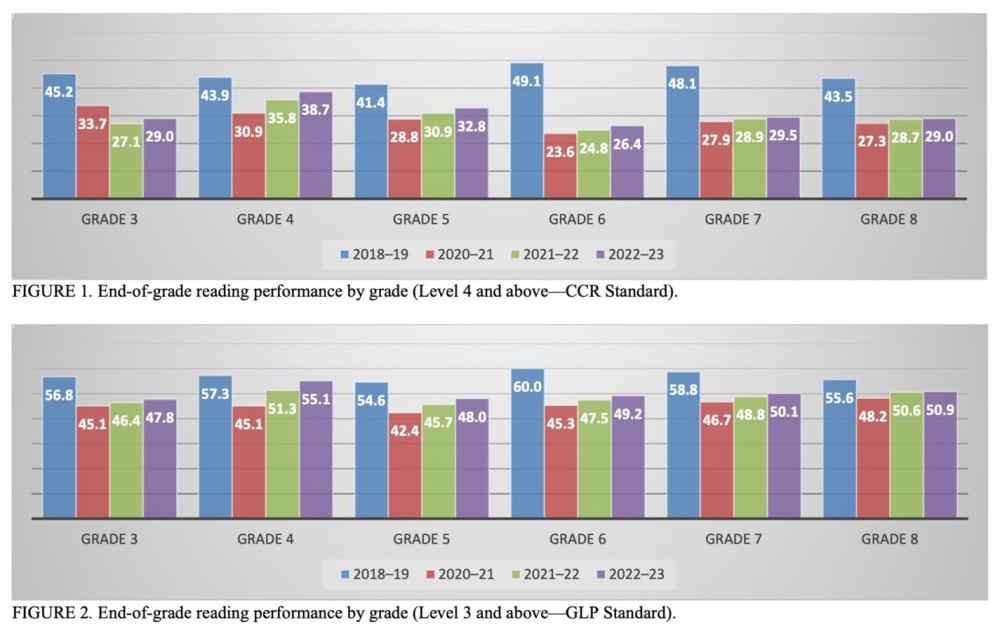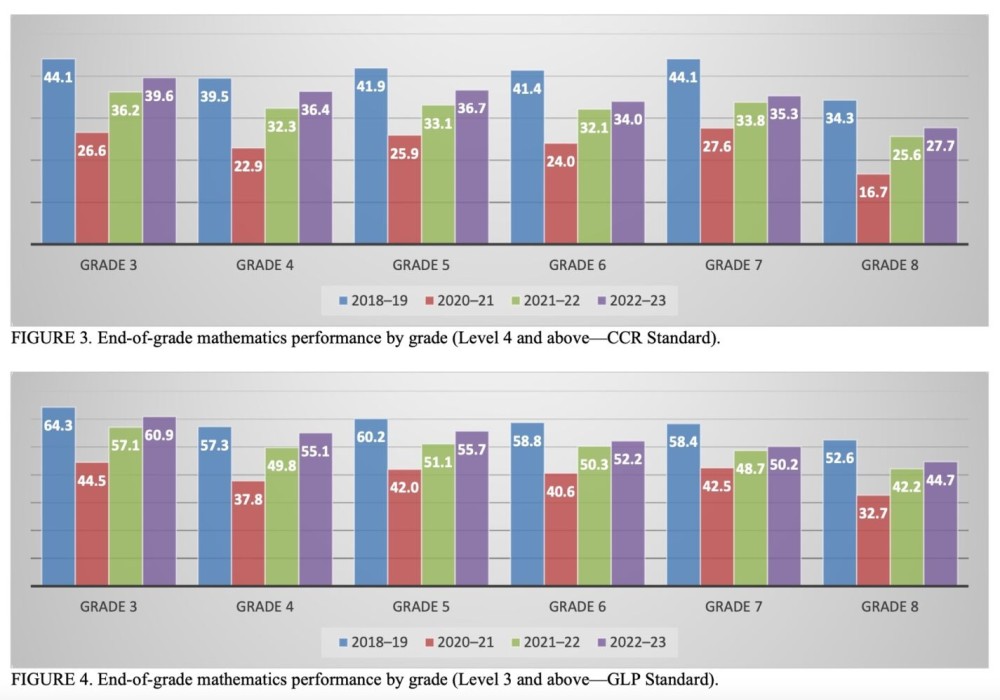A Constitutional Republic, where the First Amendment is Essential to OUR Survival
State Test Scores Offer A Mixed Bag of Results
Publisher's Note: This post appears here courtesy of the John Locke Foundation. The author of this post is Dr. Robert Luebke.
Earlier this week at the State Board of Education meeting in Raleigh, education officials released results of annual tests, school report cards, and graduation rates. Results show continued improvement in nearly all subjects, grades, and subgroups. While the boost in scores is welcome, the excitement is tempered by the fact that overall scores still lag below prepandemic levels.
Student achievement data are based on an analysis of the End-of-Grade and End-of-Course tests, which are aligned to the North Carolina Standard Course of Study in English Language Arts (Reading), Mathematics, and Science. The results reflect the percentage of students who scored at Level 3 and above (grade level proficiency) and Level 4 and above (college and career readiness) at each academic achievement level.
So what do the results tell us? Scores in nearly all areas were up over last year, even though results remained below pre-pandemic levels. End-of-Grade reading performance for eighth graders improved slightly for Grade Level Proficiency, increasing from 50.6 percent to 50.9 percent, but still lagged pre-pandemic levels. The same - slight improvements over last year but still lagging overall - can be said for mathematics at both Level 3 (Grade Level Proficiency) and Level 4 (College and Career Readiness).
End-of-Grade Reading Performance by Grade (Levels 4 and 3)

End-of-Grade Mathematics Performance by Grade (Levels 4 and 3)

While trendlines continue to move in the right direction since the Covid lows, a deeper dive into the data reveals worrisome signs. Disaggregating the data reveals that efforts to narrow achievement gaps have largely failed. Dividing scores by race shows in many areas the achievement gap between blacks and whites has actually widened. Even with a slight uptick the last two years, proficiency scores for minorities - American Indians, Hispanics, and Blacks - in many subjects remained dreadfully low and consistently lagged those of Whites and Asians. Why? It's a question beyond the scope of this article, but it's one certainly worth asking.
In addition to test scores, the report also included school report cards. The letter grades (A though F) each school received were derived from a formula in which 80 percent of a school's score was based on the percentage of students passing state exams and 20 percent was based on academic growth. In 2023 the percentage of schools receiving A's was 6.9 percent; B's, 19.8 percent; C's, 37.8 percent; D's, 27.4 percent; and F's, 8 percent.
The percentage of schools that received A's and B's (26.7 percent) was up from the previous year but still well below pre-pandemic levels - 37.3 percent of schools had received A's or B's in 2018-19.
The percentage of schools receiving C's was up, too (37.8 percent), but down from the 41 percent in 2018-19. The percentage receiving D's and F's was down (35.4 percent) but still much higher than the 21.8 percent of schools that received D's and F's in 2018-19.
The report also included data on low-performing schools and districts. While the number of low-performing schools and districts declined over the previous year, it is unsettling that the number of low-performing schools remained almost double the pre-pandemic level. Lastly, the number of Recurring Low-Performing Schools has exploded (up 194 schools in one year).
It's easy to get lost in all the data. Nevertheless, four themes percolate from our quick analyses.
Improvement is occurring. As frustrating as the pace of improvement is, teachers and principals should still be given credit for keeping things moving in the right direction. We must remember that improvements are a result of a baseline that cratered during the pandemic. Yes, recent scores were improvements. Still, college readiness and proficiency rates in the forties is certainly not a long-term goal.
Disaggregated data reveal deeper problems. When dividing test scores among races, the results are not good for minority students. Despite spending millions in new programs, achievement gaps persist. Achievement gaps between Whites, Blacks and Hispanics have not improved appreciably and seem intractable. While the report breaks down results by race, a breakdown by traditional public and charter schools is conspicuously absent. The report also mentions an increase in the number of continually Low-Performing Charter schools, but even though that information is readily available, the report fails to mention anything about the overall performance of charters. Why?
Variations among districts require further study. The report also highlights the variation in academic performance across districts, schools, grades, and subgroups. And there is plenty of it. Why does Tyrrell County, which spends $21,844 per student, fare so poorly on proficiency in math and reading, while other districts can spend considerably less and have higher rates of proficiency? Clearly how districts spend money is as important as how much money is spent.
Parents and policymakers must be more vocal in determining how and where to spend Covid funds. State Superintendent of Public Instruction Catherine Truitt should get credit for steering the Department of Public Instruction through the choppy waters of a pandemic and keeping the focus on academic achievement and what schools need to do. The federal government provided North Carolina with $6.2 billion in resources to help address school needs during Covid and especially address learning loss. Regrettably, however, about 54 percent of those funds went to pay salaries and benefits for teachers and other staff instead. A review of government expenditures showed that very little of North Carolina's Covid relief funds were used for direct, intensive tutoring. While we can determine how much has been spent, there is no way to determine whether policymakers are spending money effectively and making a difference. Schools need to be more focused on ensuring resources get to where they are needed and are used effectively for the purpose they are intended to serve.
The recent release of state test scores shows some good things as well as unsettling larger patterns. The low yet improving scores underscore the need for parents and policymakers to hold local school leaders accountable. Policymakers should also be aware there are proven ways to boost student achievement.
North Carolina school districts still have about $1.5 billion in Covid funding that remains unspent. The research has shown intensive tutoring is the best way to remedy pandemic-related learning loss. Sadly, too many districts in North Carolina have been slow to adopt such efforts. If they have a compelling reason for their reluctance, we've yet to hear it.
Schools and districts that refuse to invest in proven initiatives jeopardize the futures of the students and communities they serve.
Go Back
- State test scores show slight improvement over last year's scores but still trail prepandemic levels
- The hard work of teachers and students should be recognized; however, problems remain, achievement gaps persist, and the number of low performing schools has exploded
- These results underscore the need for schools to assess the impact of federal Covid funding and to invest additional resources in proven strategies to boost academic achievement like intensive tutoring
Earlier this week at the State Board of Education meeting in Raleigh, education officials released results of annual tests, school report cards, and graduation rates. Results show continued improvement in nearly all subjects, grades, and subgroups. While the boost in scores is welcome, the excitement is tempered by the fact that overall scores still lag below prepandemic levels.
Student achievement data are based on an analysis of the End-of-Grade and End-of-Course tests, which are aligned to the North Carolina Standard Course of Study in English Language Arts (Reading), Mathematics, and Science. The results reflect the percentage of students who scored at Level 3 and above (grade level proficiency) and Level 4 and above (college and career readiness) at each academic achievement level.
So what do the results tell us? Scores in nearly all areas were up over last year, even though results remained below pre-pandemic levels. End-of-Grade reading performance for eighth graders improved slightly for Grade Level Proficiency, increasing from 50.6 percent to 50.9 percent, but still lagged pre-pandemic levels. The same - slight improvements over last year but still lagging overall - can be said for mathematics at both Level 3 (Grade Level Proficiency) and Level 4 (College and Career Readiness).
End-of-Grade Reading Performance by Grade (Levels 4 and 3)

End-of-Grade Mathematics Performance by Grade (Levels 4 and 3)

While trendlines continue to move in the right direction since the Covid lows, a deeper dive into the data reveals worrisome signs. Disaggregating the data reveals that efforts to narrow achievement gaps have largely failed. Dividing scores by race shows in many areas the achievement gap between blacks and whites has actually widened. Even with a slight uptick the last two years, proficiency scores for minorities - American Indians, Hispanics, and Blacks - in many subjects remained dreadfully low and consistently lagged those of Whites and Asians. Why? It's a question beyond the scope of this article, but it's one certainly worth asking.
In addition to test scores, the report also included school report cards. The letter grades (A though F) each school received were derived from a formula in which 80 percent of a school's score was based on the percentage of students passing state exams and 20 percent was based on academic growth. In 2023 the percentage of schools receiving A's was 6.9 percent; B's, 19.8 percent; C's, 37.8 percent; D's, 27.4 percent; and F's, 8 percent.
The percentage of schools that received A's and B's (26.7 percent) was up from the previous year but still well below pre-pandemic levels - 37.3 percent of schools had received A's or B's in 2018-19.
The percentage of schools receiving C's was up, too (37.8 percent), but down from the 41 percent in 2018-19. The percentage receiving D's and F's was down (35.4 percent) but still much higher than the 21.8 percent of schools that received D's and F's in 2018-19.
The report also included data on low-performing schools and districts. While the number of low-performing schools and districts declined over the previous year, it is unsettling that the number of low-performing schools remained almost double the pre-pandemic level. Lastly, the number of Recurring Low-Performing Schools has exploded (up 194 schools in one year).
It's easy to get lost in all the data. Nevertheless, four themes percolate from our quick analyses.
Improvement is occurring. As frustrating as the pace of improvement is, teachers and principals should still be given credit for keeping things moving in the right direction. We must remember that improvements are a result of a baseline that cratered during the pandemic. Yes, recent scores were improvements. Still, college readiness and proficiency rates in the forties is certainly not a long-term goal.
Disaggregated data reveal deeper problems. When dividing test scores among races, the results are not good for minority students. Despite spending millions in new programs, achievement gaps persist. Achievement gaps between Whites, Blacks and Hispanics have not improved appreciably and seem intractable. While the report breaks down results by race, a breakdown by traditional public and charter schools is conspicuously absent. The report also mentions an increase in the number of continually Low-Performing Charter schools, but even though that information is readily available, the report fails to mention anything about the overall performance of charters. Why?
Variations among districts require further study. The report also highlights the variation in academic performance across districts, schools, grades, and subgroups. And there is plenty of it. Why does Tyrrell County, which spends $21,844 per student, fare so poorly on proficiency in math and reading, while other districts can spend considerably less and have higher rates of proficiency? Clearly how districts spend money is as important as how much money is spent.
Parents and policymakers must be more vocal in determining how and where to spend Covid funds. State Superintendent of Public Instruction Catherine Truitt should get credit for steering the Department of Public Instruction through the choppy waters of a pandemic and keeping the focus on academic achievement and what schools need to do. The federal government provided North Carolina with $6.2 billion in resources to help address school needs during Covid and especially address learning loss. Regrettably, however, about 54 percent of those funds went to pay salaries and benefits for teachers and other staff instead. A review of government expenditures showed that very little of North Carolina's Covid relief funds were used for direct, intensive tutoring. While we can determine how much has been spent, there is no way to determine whether policymakers are spending money effectively and making a difference. Schools need to be more focused on ensuring resources get to where they are needed and are used effectively for the purpose they are intended to serve.
The recent release of state test scores shows some good things as well as unsettling larger patterns. The low yet improving scores underscore the need for parents and policymakers to hold local school leaders accountable. Policymakers should also be aware there are proven ways to boost student achievement.
North Carolina school districts still have about $1.5 billion in Covid funding that remains unspent. The research has shown intensive tutoring is the best way to remedy pandemic-related learning loss. Sadly, too many districts in North Carolina have been slow to adopt such efforts. If they have a compelling reason for their reluctance, we've yet to hear it.
Schools and districts that refuse to invest in proven initiatives jeopardize the futures of the students and communities they serve.
























